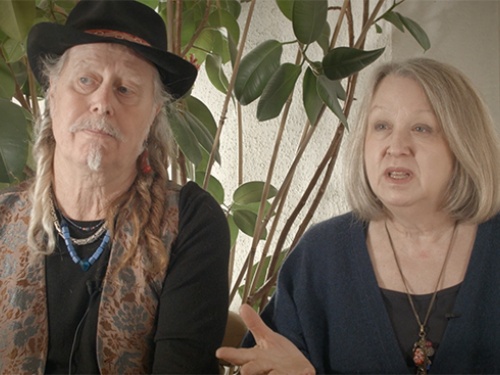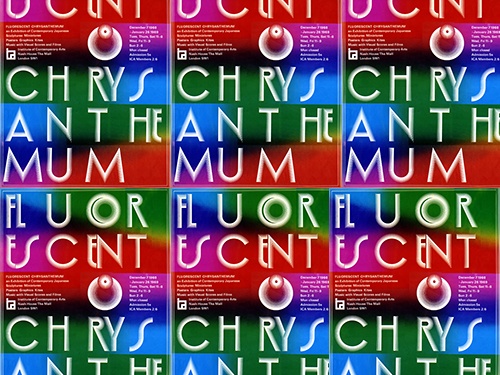Remote Control Interview with Simon Denny and Ira Schneider
This week members of our Student Forum talk to artists Simon Denny and Ira Schneider. Schneider is a pioneer of experimental video, and since 1969 has played a major role in the politics of video distribution. Denny was responsible for part of the gallery installation in our current exhibition Remote Control; the massive television signal Hub - an exhausted bit of grey equipment which was the engineering behind the distribution of the TV signal for the whole of North East London.
Led by the Forum's questions, the artists have a conversation about the different perspectives that working in both analogue and digital periods provoked. Hear more about what the Student Forum has to say about Remote Control, on the Student Forum Blog.
Ira begins by talking about the last time he visited London:
Ira: I was travelling around the world for a project called Timezones, where in one room, on 24 TV screens you could see all around the world at the same time. I was videotaping in London, but also in Papua New Guinea, in Africa, around the world. That’s because there was no global satellite coverage in 1977. Only two-thirds of the world was connected for real-time communications.
Cameron (Student Forum): How have you found the advances in technology have affected your work since then.
Ira: Well that’s why I’m here. I keep renewing… it keeps renewing me. Back then I carried 72 video cassettes that were this big (gestures). Sony video cassettes, in black garbage bags so that you could never see the word ‘Sony.’ And it worked – we never had anything stolen. And the camera was that big (massive) – and this is my camera today (phone-size) and next time in a couple of years I’ll be doing it with just a ring, a ring on my finger.
Simon: Maybe with the finger itself.
Ira: Yeah (laughs) (points his finger at us) ‘Hey you’re on TV!
Seth (Student Forum): When did you both start working with film or video?
Simon: I was at art school in New Zealand making sculpture but when I started travelling, I started working in video
Ira: When was this, the 90s?
Simon: No no, early zeros, not that old!
Ira: Wow
Simon: From travelling, I thought it was kind of ridiculous to be making rooms with stuff in it, so I started working with more ephemeral technology from my computer and that’s when I got into the history of video, and started making videos for my own presentations.
Ira: I started doing video in January 1969.
Seth: As a student?
Ira: No. I had a master’s degree by then in psychology and made 8 short films.
Simon: You were about my age then? I’m 29
Ira: Yes, actually, I was about 30. I discovered I couldn’t go on making films because they cost too much and I didn’t get a return because they were experimental films, and played only in underground cinemas and didn’t return much money. So I switched to video and then suddenly I had sync sound, because in film it was too complicated and expensive, and you always had to travel around with somebody who held the microphone and did the sound.
Seth: Science fiction writers like Ballard and Kurt Vonnegut were prophetic about the way in the changes in information technology would radically alter or colonise inner space or the mind in some way. They were accurate about the physical way that this technology would come to permeate everything we do. I was wondering about that future that these writers imagined, that we seem - to some extent at least- to inhabit.
Simon: In terms of prediction, one of the main problems that Ira’s generation probably faced when they were first starting to work with video was distribution. Artists didn’t have the same access to distributing information as the main networks did. No one predicted how easy distribution would become. Now all of us have access to distribution but what we might not have access to is the intense marketing tools that are standard in media industries.
Ira: Getting paid for it!
Simon: One of the aspirations of Ira’s generation seemed to me to be trying to use televisual technology to produce less sensationalist, closer to the everyday, more realist, ecologically sound material, to use video in what they felt to be a more positive way and not only commercially. Now the same kind of - maybe sensationalist material that Ira’s generation was working against, still gets pumped out and this is what we all come into contact with. [Digital distribution hasn’t necessarily improved the chances of non-commercial, unsensational material, to find an audience]. So even if I’m wanting to find an audience on YouTube, a young kid farting on a mouse or whatever is going to be better suited to finding large audiences than, say, amateur social realist documentaries, because of the nature of what viewing YouTube is like as an experience.
Ira: Yeah, Bohemian Rhapsody in the back of a police car, singing the whole song, and it got on CNN
Simon: It’s not what I have the impression Ira’s peers were hoping to use that network for.
Ira: There is this crap about ‘Clash of the Titans,’ ‘Revenge of the Titans,’ ‘The Killing of the Titans’ these big monster things. Now, it’s these giant things that come from games. It’s all crap and unfortunately that’s what’s dominating the experience of young kids today.
Simon: I slightly differ on my opinion on that. I think that often the material that is used is not so interesting but the forms are. I know people that do very inventive and progressive things with that kind of stuff. Do you know what I mean?
Ira: With the technology, yes. Not only shooting other people…
Seth: Can the gaming form, where you can indulge fantasies or pathological ideas but without there being any physical harm, have some beneficial social effect?
Simon: Well, there have been studies on exactly that, actually. There are claims that it’s cathartic if people play out those fantasies out, not in reality.
Ira: It goes back to archaeology and anthropology. The human being is born of the Savannah, with wide expanses of flat land where the eyes developed into a tracking tool so that you could hunt the prey. We embody this coordination, this calculus. This is it! I’m reaching and eye and hand (reaches for his glass of water). The ability to track over time the movement and bring things together. Calculus does that and we have it in us! That’s just the description of what we are doing. How we function. That’s what these games are.
Simon: Some people would argue that any kind of technology is just an extension of people. The body is already a prosthetic and so any other technology that you can put on top of that is just the same as the body.
Cameron: Would you see modern technology as being neutral?
Simon: No I don’t think it’s neutral. In terms of social media for example, my personal position is that social media isn’t necessarily evil but it certainly puts things into a particular environment. Facebook makes money partially by giving very detailed demographics to their advertisers. That’s the fundamental underlying function of that business. The social function that happens between us when we use it is something different.
Ira: Just be careful what you put on it because they own it.
Simon: Exactly, yes they own it, they own everything. There was a guy who requested all of the information that Facebook had on him and a very substantial dossier came and it still wasn’t everything. They have a vast data mine and apparently they’re only just starting find good ways to use that vast amount of detail. I think we’re also not at the moment seeing what will come out of all this knowledge gathering that’s happening because the processing is only starting.
Seth: You have no idea where that information might end up. It might not fall into benign hands.
Simon: Yes, exactly. I have friends who think it’s absolutely fine; this is just the forces of survival of the fittest happening. I’m not sure that I believe that myself and would imagine that Ira doesn’t. If you give all these people this information they have all this power. You’ve got nothing for it. You’re at the whim of a small minority still deciding what they want to do with detailed information from people like us. I’m a bit on the fence with it myself - I can see both ways.
Cameron: People say that the Arab Spring would not have happened without social media.
Simon: Yes, this is true, but it’s only a small part of what that technology’s doing. Ok, you can enable people to do that, but there are other sides of things happening at the same time. There’s this great little meme that I saw on 4chan that’s two chickens in a chicken coop saying ‘isn’t it great that we have all this free food!’ I don’t know if that is the situation but that’s one way of reading it.
Cameron: How would you see your own practice in relation to these technologies?
Simon: It’s something that I’m totally consumed with processing, in a different way and in a different moment, from people like Ira. Ira’s been doing it for a lot longer than I have.
Seth: Artists in the early twentieth century were very quick to recognise the ability of film - or moving images on a screen - to work on the mind covertly, its form analogous to something like the unconscious. Do you see a different relationship to the screen now? How does a kind of complete immersion in moving images affect us psychologically?
Simon: It depends how, where and when it’s experienced maybe?
Seth: What type of content do you look for?
Ira: I prefer reality, abstraction from reality, and juxtaposition. Other people prefer sensationalism. There was a woman - la Fontaine- she did a video installation with 24 screens. Each screen had the same guy on it doing the same dance. What the fuck is that. Nam June Paik had 100 screens with the same image on every screen: what the hell is that about. Bigger sells is what it is, not content.
Simon: My reading of what Ira is interested in is human scale, something closer to a human level. Making it bigger and more saturated is definitely not what I think Ira is interested in. He is interested in the capability of that technology to deliver video information, audio information to different place.
Ira: I have a bias in my own work, which for the most part is non-narrative. I don’t do stories. I assemble images and sounds to pass information along in a non proscenium way, whereas the television set is thought of as a stage. I often do installations with one or more screens . Even when I am doing a one screen video, its many different scenes, different people, different locations and somehow I tie them all into each other.
Simon: That is where we crossover. I’m interested in the way information reaches us, what our interaction with the world feels like through information. I’m not only interested in video, but this is something that is very common in terms of the way we receive information so therefore one looks at it. I’m also interested in graphics and the way that they speak, and what their content is. I’m interested in looking at what the machinery is for visually and audibly describing ideas is.
Ira: I have a book to suggest - McChesney & Nichols : Our Media not Theirs. It’s straight to the point, a good starting point for artists using television.
Seth: Some of your previous bits of work uses found bits of video - often generic content relaxation videos, self help films, that set up (or are intended to set up) a very personal or emotional relationship with its audience. I was wondering why you look at that sort of material.
Simon:I don't always work with found material. I make things as well. For one project I used a relaxation video because I was trying to use fish tank imagery that was part of kind of art history dealing with video. The fish tank is often used as a kind of metaphor for the TV box. This was a history I was interested in participating in. On another project I recently finished, I worked with a psychologist trying to devise a non linear time line for a history of work and society in New Zealand (where I am from). That could seem like generic material, but actually takes the style of PowerPoint and other formats that are often used to set out this kind of information, but coming to a more interesting way of using that kind of aesthetic. For every project I try and have a very specific aim, what I want out of it, and how I will go about doing it. So I provide myself with a very particular problem, which I then try and solve in the best way possible. It is not a formula that always works, but it is kind of template.
Seth: Is that a formula that you applied to remote control?
Simon: Yes definitely, because I was asked to design this room that would be a touchstone for a number of video art pieces from the 1960’s to 1980’s, dealing with the subject of television. This is why I brought Ira‘s material into it because it seemed to me so poignant/relevant to how people started thinking about dealing with this subject. The focus that Radical Software published by Raindance Corporation [a group that that Ira was involved in] put on television is for me a very useful one for thinking about what came later, especially the emphasis on information distribution. The moment I got this giant transmitter -TV4 - this huge piece of equipment sitting in the gallery that was only able to happen because of the digital analogue switchover that is happening in London right now. We can only house this huge object that can be applied as a symbol for the mass distribution of media, because it is being thrown out at this moment.
Cameron: How did you acquire this monument?
Simon: While researching for the show I came across the fact that the show was opening at the same time as the switchover - which is a good time to comment on artists and television. I tried to find out who owned this bit of broadcasting equipment, I got the ICA curator to help me get in touch with go tos for that, and its all owned by a private company Arqiva, who donated the equipment to us. They own every single bit of broadcast hardware in the UK. We managed to convince them to give us Chanel 4’s transmitter for North East London.
Ira: Did they pay for delivery. Because that’s important
Simon: They did, 5 men came down to deliver it so it was quite a big deal.
Ira: What are you going to do with it after? Is it going into your apartment?
Simon: I wish.
Seth: Did channel four reach the entire country through that bit of equipment:
Simon: No, this is one part. The way it works is that you have several signal hubs, and you have this situation where every channel sends their video signal from the studio to this hardware, that then kind of blows it up, amplifies it and then sends it via these giant antennas that are all around. But that is just a fraction of the mass of material - one part for Channel 4 for North East London. It is only part of the line that processes Channel 4. But I think it visually gives you some sense of scale in the gallery.
Ira: are there any rare earth metals in there?
Simon: There are amazing copper ones, huge chunks on the transformers. This obsolescence cycle is so quick and happens so much, there is such a mass of things that get used and then re-used.
Cameron: It’s also a kind of abstraction, because you never see this kind of object, you are presented with something that is completely removed from any kind of context.
Simon: Well this is the one of the reasons I wanted to bring this bit of equipment in. It also speaks of Google’s situation, where you have this idea of the cloud, some immaterial resource where you’re information can be stored. But of course it’s not a cloud, its some huge warehouse, packed with enormous powerful machines, using lots of resources and power. This is the idea, to bring that very material force into view.
To watch Simon Denny talk further to Ira Schneider about Remote Control and his pioneering video work, head over to our YouTube channel.
This article is posted in: Blog
Tagged with: interview, remotecontrol, televison, videoart





